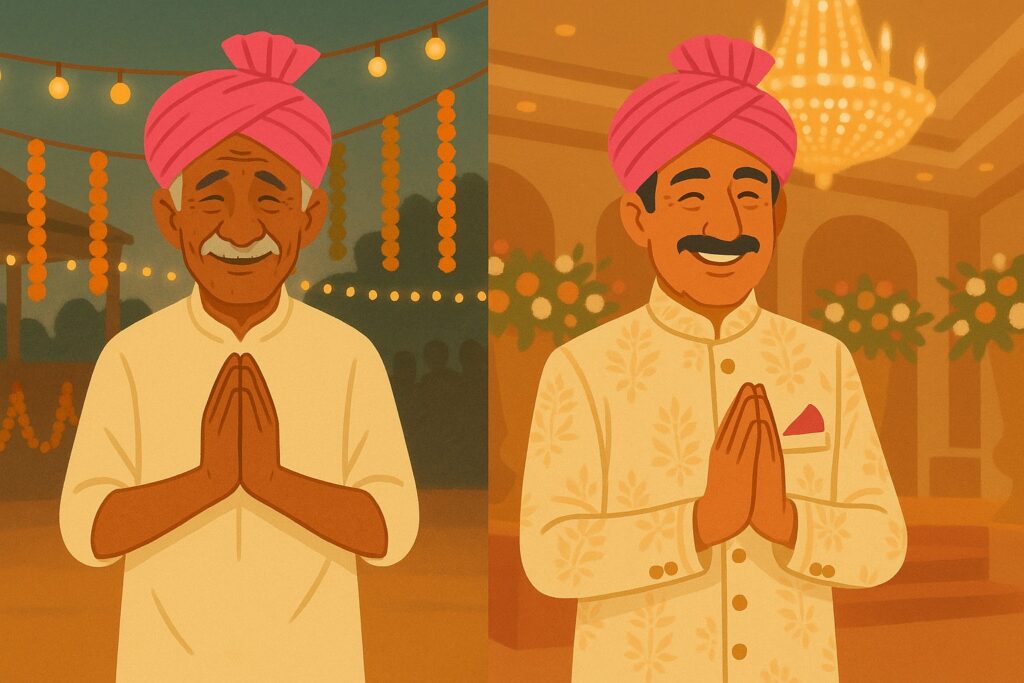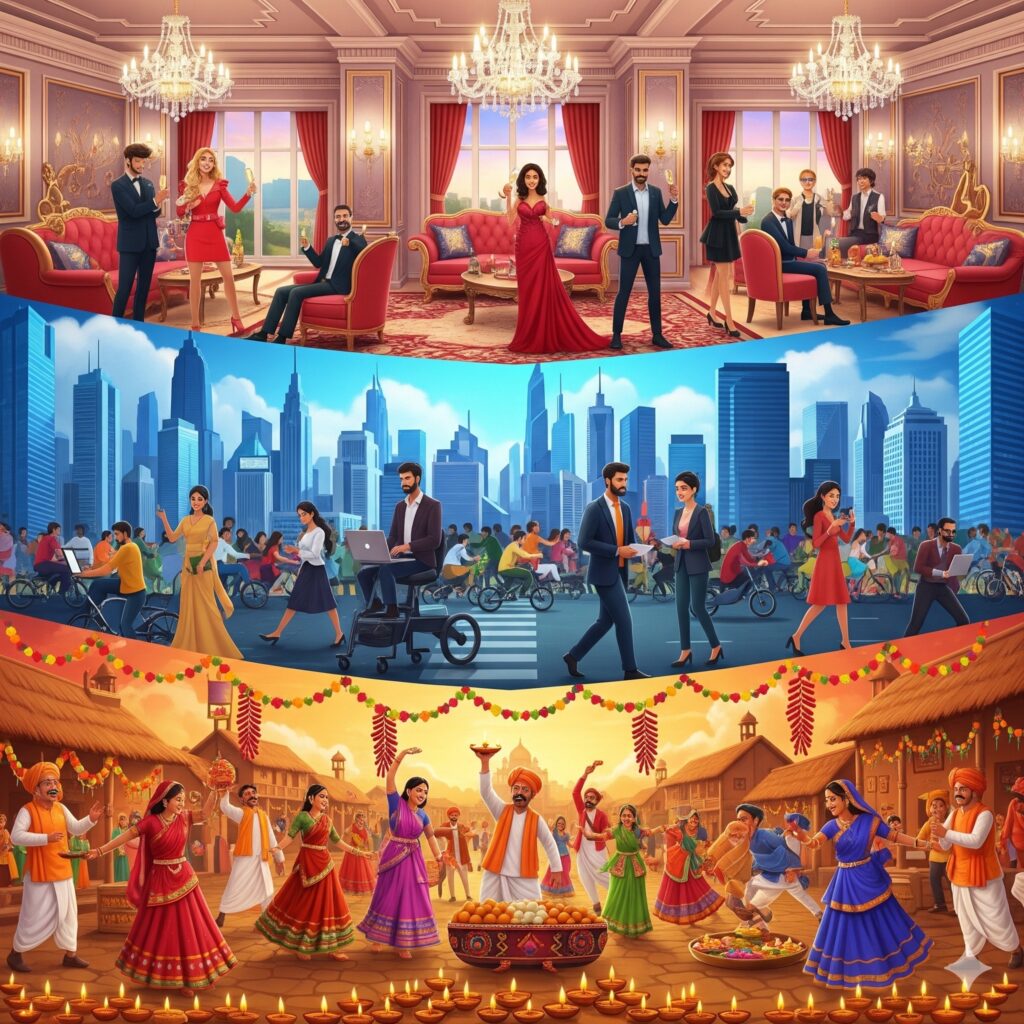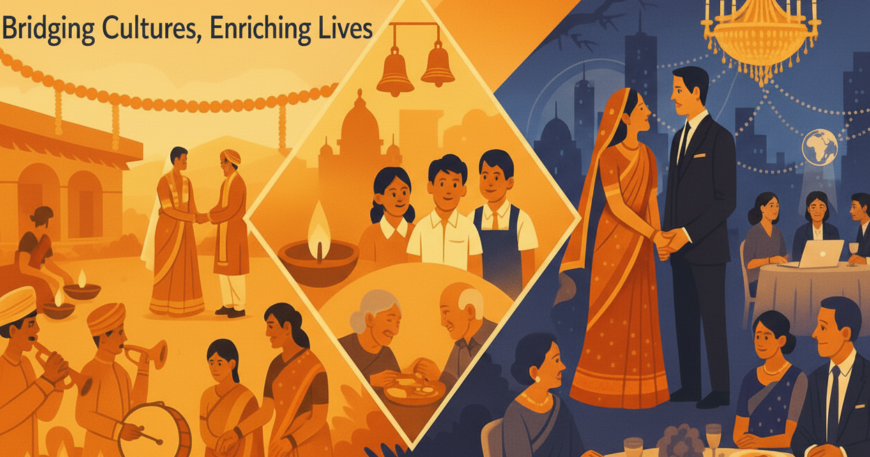Introduction
The word “poverty” carries heavy baggage in modern global discourse. To Western economists, being poor often means exclusion from consumption, lack of access to branded goods, or inability to live up to a material standard of life. Yet, when the same lens is applied to India, it often produces distortions.
India, despite its economic challenges, cannot be simplistically painted as a “banana republic” of stark wealth inequality. Instead, it increasingly resembles what I call a “diamond society”—a nation where there is a growing, thick middle class, a visible wealthy elite at the top, and at the base, millions who may live simply, but not necessarily in misery.
What makes this unique is that India’s “wealth” is not only material but also cultural and spiritual. To miss this is to misunderstand the very essence of Indian society.

Poverty in the Western Lens
In most Western countries, to be “poor” is to be cut off from the mainstream of life. It often translates into:
- Social isolation: living alone, without community celebrations or support.
- Homelessness or insecurity: not having stable shelter.
- Stigma: being visibly left out of the consumption race.
A poor American or European often feels excluded from society’s rhythm—unable to host events, participate in festivals, or celebrate life milestones with dignity.
The Western idea of wealth is linear and materialist: you are rich if you consume more, poor if you consume less.
The Indian Diamond: Layers of Society
In India, the social structure is far more layered and nuanced. If we imagine it visually:
- Top tip of the diamond: The ultra-rich—industrialists, tech leaders, Bollywood stars, political families—who enjoy global lifestyles.
- Broad, thick middle: The urban middle class and the upwardly mobile, with rising aspirations, better education, and strong consumption.
- Broad base: Villagers, farmers, artisans, and small-town families who live with fewer material means but with strong cultural capital.
What makes India unique is that the base is not hollow. Villages and towns are filled with people who live simply but do not see themselves as destitute, because their lives are interwoven with festivals, spirituality, joint families, and a philosophy of contentment.
Example: The Wedding Celebration
Perhaps no event captures this better than the Indian wedding.
- In a wealthy family in Mumbai or Delhi, a wedding may unfold in a five-star hotel, with celebrity performers, Bollywood dance troupes, designer outfits, and global cuisines.
- In a small town, the same wedding may happen in a municipality hall, an open field, or a village ground. The food may be cooked by relatives, the band a local brass troupe, the clothes modest.
Yet in both cases, the fervor is the same. The music is loud, the lights are bright, the rituals are intact, and the bride’s send-off is equally emotional.
Here lies the beauty: happiness is not proportional to expenditure. A villager may spend ₹1 lakh, a businessman ₹1 crore, but the joy in the rituals and community is equally intense.
This is not poverty—it is living within one’s means while maximizing joy.
Contentment as Wealth
The idea that you can be happy within your means is deeply embedded in Indian philosophy.
- The Bhagavad Gita does not call for blind adherence to scripture but emphasizes svadharma (one’s own duty) and yoga (equanimity in action).
- Sanatan Dharma (often called Hinduism) is not a rigid religion but a way of life—fluid, adaptive, and progressive. It teaches that wealth is not just artha (money), but also dharma (duty), kama (fulfillment), and moksha (liberation).
Thus, a family that shares meals together, celebrates festivals, and fulfills duties toward community and guests is considered prosperous—even if their bank balance is modest.
Cultural-Spiritual Wealth vs. Material Wealth
Consider two households:
- A Western household with low income:
- Parents may work multiple jobs, have no time for family meals.
- Social security provides survival, but cultural participation may be minimal.
- Festivals are commercialized; family gatherings may be rare.
- An Indian rural household with modest income:
- They may grow their own food, live in a joint family, and own their house.
- Festivals like Diwali, Holi, Pongal, or Eid bring entire communities together.
- Music, dance, rituals, and storytelling give joy that is independent of money.
The difference is profound: in India, even “poor” families are culturally and spiritually rich, often far more socially connected than low-income families in the West.

Festivals as Equalizers
Take Diwali or Durga Puja.
- In a metro city, people may buy designer outfits, imported sweets, and decorate homes with LED lighting.
- In villages, people may light clay diyas, cook traditional sweets at home, and wear simple cotton clothes.
But the essence—sharing sweets, lighting lamps, telling stories of Ramayana or Durga’s victory—is the same. The spiritual joy levels the ground.
Similarly, Eid in a village may involve homemade biryani shared with neighbors, while in a city it may be celebrated with lavish feasts. Yet both carry the same heart of togetherness.
The Hindu Way of Life: Evolution, Not Rigidity
Another reason India cannot be reduced to “poor vs. rich” binaries is the flexibility of its civilizational philosophy.
Unlike Abrahamic religions that often emphasize strict scripture, the Hindu way of life is:
- Non-dogmatic: Multiple gods, paths, and interpretations coexist.
- Adaptive: Traditions evolve with time—today you may see eco-friendly Ganesh idols or online satsangs.
- Progressive in spirit: At its best, Hindu philosophy encourages viveka (discrimination, discernment) and parivartan (change).
This flexibility means that Indians can live happily at different material levels without feeling “lesser.” The farmer and the CEO may celebrate the same Diwali with different scales but similar devotion.
Why Western Lens Misreads India
Western observers often miss this because their benchmarks are different:
- GDP per capita = success.
- Material consumption = happiness.
- Individualism = modernity.
By these measures, India looks poor and unequal. But if you measure cultural participation, spiritual resilience, and community bonding, India looks far richer.
It’s why a villager with two cows, a field, and a family around the chulha (hearth) may feel happier than a Western worker in a lonely apartment.
India’s Diamond Society in Action
- The Elite Tip
- Jet-setting billionaires, global CEOs, political dynasties.
- Drive modern India’s global ambitions.
- The Growing Middle
- Engineers, IT workers, entrepreneurs, teachers, small traders.
- Aspirational, consumption-driven, forming the backbone of urban India.
- The Base
- Farmers, artisans, daily wage earners.
- Materially modest but sustained by cultural-spiritual wealth—festivals, rituals, music, temple networks, village solidarity.
Together, this forms a diamond: not a pyramid of misery, but a society where even the bottom has richness of life beyond GDP numbers.
The Philosophy of “Happiness Within Means”
At the core of this lies an Indian ethos: santosha—contentment.
- A villager may not own a car, but his daughter’s wedding is celebrated with as much pride as a millionaire’s, just scaled to his reality.
- He may not eat exotic cuisines, but seasonal vegetables cooked with family recipes bring equal joy.
- He may not vacation abroad, but pilgrimages to local shrines give the same sense of wonder and renewal.
This is the genius of Indian civilization: to democratize joy through culture and spirituality, not just money.
Lessons for the World
As global inequality rises, India’s example has lessons:
- Happiness ≠ material parity: A society can thrive when cultural and spiritual wealth cushions economic inequality.
- Community matters: Shared festivals, rituals, and traditions prevent the loneliness epidemic common in wealthy countries.
- Philosophy shapes economics: A worldview that sees life as duty, growth, and evolution—not just consumption—creates resilience.
Conclusion
India is not a banana republic. It is a diamond society, with a broadening middle class, a visible elite, and a base that may look “poor” in Western eyes but is sustained by a treasury of culture, spirituality, and community.
The West often defines poverty as the inability to consume. India redefines it: to live within one’s means, to celebrate with dignity, and to find joy in culture, family, and faith.
This is why, in India, even the humblest family lights its diyas, plays its bands, serves its food, and sends off its daughter with as much pride as the richest man in the city.
This is not poverty. This is civilizational wealth.
And this—perhaps—is India’s greatest export to the world.
An Invitation to Experience
At Le Frehindi, we believe that this essence of India—simple living, high thinking, and cultural-spiritual wealth—is best understood not through textbooks but through experience.
This is why we actively promote experiential trips for Western students to visit India and see how joy, dignity, and freedom can thrive within modest means.
To live in a village, celebrate local festivals, eat at family tables, and participate in weddings or community rituals is to understand a truth that India has carried for centuries: happiness is not about how much you spend, but how much love and meaning you create.
If you are a school, a parent, or a Westerner who would like to take part in such programs, do write to me at: ceo@lefrehindi.com
Come, discover India’s diamond society—where you can be happy, free, and guiltless in living simply within your means.
Haru Mehra
President, Le Frehindi






